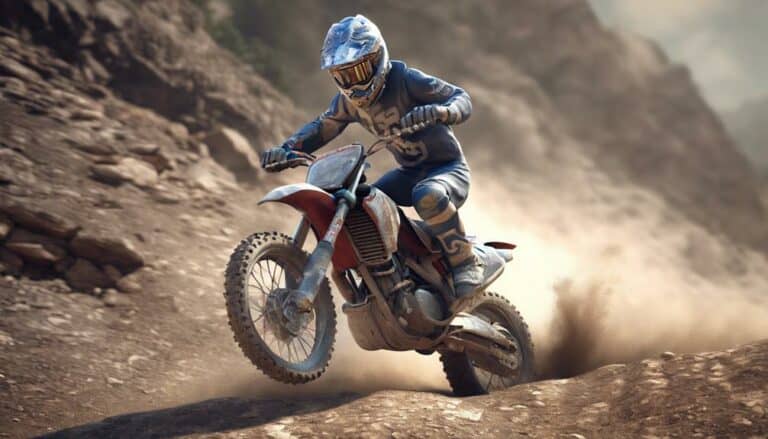You might not realize the significant impact body positioning has on maintaining traction and grip while traversing various terrains on a dirt bike. How you position yourself on the bike can make all the difference between a smooth ride and a challenging one.
From flat to rocky, uphill to downhill, each terrain demands a specific adjustment in body posture to optimize control and stability. Understanding these nuances could elevate your riding skills to a whole new level, enhancing your performance and safety on the trails.
Key Takeaways
- Centering body over bike's pivot optimizes traction on flat terrain.
- Leaning forward on uphills maintains front wheel contact and stability.
- Shifting weight back increases traction on downhill paths for control.
- Distributing weight towards the rear enhances grip on sandy and rocky terrains.
Traction and Grip on Flat Terrain
To enhance traction and grip on flat terrain while riding a dirt bike, maintaining proper body positioning is important for stability and control. When tackling flat surfaces, your body position plays a vital role in maximizing traction. By centering your body over the pivot point of the bike, you optimize weight distribution across both wheels, enhancing grip. Keeping your chin over the handlebars and your elbows bent upward and outward not only stabilizes your body but also improves handling by allowing you to react quickly to changes in the terrain.
Proper body posture on flat terrain minimizes the risk of losing control and sliding out. This is achieved through a balanced distribution of weight on both tires, which prevents slipping. By consciously adjusting your body position to maintain stability, you can confidently navigate flat surfaces with increased traction and grip. Remember, your body is an important component in the equation for maintaining control and maximizing performance while riding on flat terrain.
Traction and Grip on Uphill Terrain
Maximizing traction and grip on uphill terrain requires precise body positioning to optimize stability and weight distribution for enhanced control. Leaning forward while uphill riding is critical as it guarantees that the front wheel maintains contact with the ground, increasing traction. By shifting your weight forward, you prevent the dirt bike from tipping backward on steep inclines, thereby improving grip and avoiding loss of control. Proper body positioning plays a key role in enhancing stability and control on uphill terrain, ultimately maximizing traction for a smoother ride.
When climbing uphill, adjusting your body position to lean forward is vital. This forward lean helps the dirt bike maintain traction by keeping the front wheel firmly planted, allowing for better grip on the challenging terrain. Additionally, balancing weight distribution between the front and rear wheels aids in enhancing grip while traversing uphill slopes. Remember, precise body positioning and weight shift are fundamental for optimizing traction and grip on uphill terrain.
Traction and Grip on Downhill Terrain
When riding downhill terrain on a dirt bike, achieving best traction and grip hinges on mastering proper body positioning to effectively shift weight back for enhanced stability and control. Leaning back slightly while keeping your weight centered over the bike is critical for maintaining traction and control on steep descents. Here are key points to ponder:
- Weighting the Rear: Shift your weight towards the rear of the bike to increase traction on downhill slopes.
- Maintain Traction and Control: By bending your knees and elbows, you aid in shock absorption and guarantee better grip on rough terrain.
- Balance and Maintain Stability: Lower your center of gravity by leaning back to enhance stability and reduce the risk of sliding on downhill surfaces.
Traction and Grip on Sandy Terrain
Shifting your weight slightly back on sandy terrain is imperative for maintaining traction and stability, especially when riding a dirt bike. Keeping the front wheel light and ensuring the rear wheel drives through the sand is key to steering through this challenging terrain. By adjusting your body position and distributing your weight towards the rear of the bike, you enhance grip and balance, preventing the front wheel from digging in and causing you to lose control.
To illustrate the importance of weight distribution on sandy terrain, consider the following table:
| Aspect | Impact on Performance |
|---|---|
| Weight Back | Enhances rear wheel traction and prevents front wheel sinkage |
| Lower Body Flex | Absorbs impacts and maintains stability |
| Balanced Grip | Allows for controlled steering and maneuverability |
Traction and Grip on Rocky Terrain
To optimize traction and grip on rocky terrain, adjusting your body positioning by shifting weight towards the rear of the dirt bike is essential. This technique keeps the front wheel light, allowing it to better navigate the uneven surface and maintain traction.
Standing on the footpegs with bent knees and elbows helps absorb impacts, providing stability and control over rocky terrain. Leaning forward while riding can also be advantageous as it weights the front wheel, increasing traction and stability.
Additionally, using your legs to balance the bike and keeping a relaxed grip on the handlebars enhances overall control and prevents slipping on rocky surfaces. By adjusting your body position to keep the bike upright and utilizing your legs for balance, you can navigate rocky terrain with better grip and stability, ensuring a smoother and more controlled ride.
Conclusion
To wrap up, your body positioning on a dirt bike is akin to a conductor guiding an orchestra – directing, balancing, and harmonizing every movement to maintain traction and grip on various terrains.
Just as a maestro commands his musicians with precision and finesse, your posture dictates the flow and rhythm of your ride, ensuring a seamless performance on the dirt bike stage.
Mastering this art will elevate your control, stability, and overall riding experience to symphonic heights.

